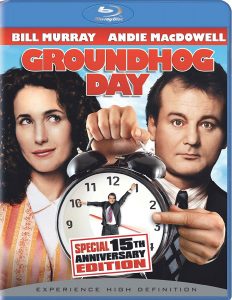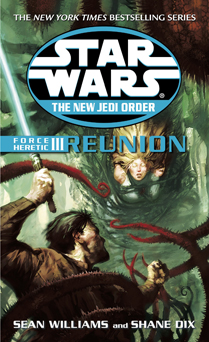Sean Williams and Shane Dix wrap up perhaps the most underrated “Star Wars” book trilogy with the 17th “New Jedi Order” entry, “Force Heretic III: Reunion” (2003). Again, they are good with describing settings, mediocre at military tactics (and there’s more of that in this book, unfortunately) and strong with delving into wartime philosophy. To give you an idea of how much they like to talk about things all day, the epilogue is 32 pages. I don’t mind this kind of “Star Wars” writing, but I appear to be in the minority judging by reviews of this trilogy at Amazon.
For fans who like action, there is more of that here, as a battle between the Yuuzhan Vong and joint Alliance/Imperial forces breaks out around the remote communications planet of Esfandia. For my part, I love the hard SF aspect of Esfandia: It’s one of those rogue planets that doesn’t have a sun. Yet it does have life, in the form of the Cold Ones, kite-like, sentient creatures who fly through the dense atmosphere and call to mind something out of an Arthur C. Clarke novel.
I remembered Esfandia more than anything else from my initial read, which is odd considering that a more famous rogue planet is the centerpiece of this story: Zonama Sekot. In the same way that the previous entry, “Refugee,” was in part a sequel to “The Truce at Bakura,” “Reunion” is partly a sequel to “Rogue Planet.” Anakin and Obi-Wan visited this living planet 50 years earlier, and now Luke, Jacen and others delve into its mysteries.
The link between the prequels and post-“Return of the Jedi” yarns was becoming common around this time, when “Episode II” was out and “Episode III” was on its way — see also “Survivor’s Quest,” “Tatooine Ghost” and a handful of “Tales” comics, including one where Luke “meets” young Anakin. The same thing happens here when Sekot (the “mind” of the planet, the physical form of which is called Zonama) takes the guise of Anakin Skywalker to communicate with Luke. Meanwhile, Sekot appears as Vergere to Jacen. Sekot holds simultaneous, identical conversations with Jacen and Luke in different locations, which makes for a clever way to contrast the uncle’s and nephew’s points of view.
Luke wants the planet – which had driven off the Vong 50 years earlier, and again just before his arrival — to be aggressive in the war effort, whereas Jacen does not – he still believes a peaceful path to ending the war can be found. Jacen’s pacifist stance is noteworthy in light of how his views will do a complete 180 by the time of “Legacy of the Force”; I’m interested to revisit the process of how he transitions to full-blown authoritarian.
Of course, both of them rejected the use of chemical weapon Alpha Red in earlier books. But Sekot wiping out Vong who contribute to the war effort is a line Luke is willing to walk up to. (This is consistent with his past role as a Rebel Alliance warrior, something he never apologized for even as he became more Yoda-like in his views.) Luke rejected Alpha Red because the Vong populace includes a relatively innocent citizenry – they are not a hive mind, like the Killiks, nor universally devout to a central religion-state, like the Yevetha. There exist Vong who might theoretically reject their culture’s warmongering status quo.

That was a vague notion earlier in the “NJO,” but Williams and Dix do a nice job in this trilogy of introducing us to the underground community of Shamed Ones on Yuuzhan’tar. While Nom Anor is stirring this disgruntled populace up for the sake of his own power play, a reader sees that there are relatively good Yuuzhan Vong out there, that they reject the domineering Supreme Overlord Shimmra, and that they even hold up the Jedi as moral examples.
(As it turns out, Luke and Jacen were right to believe in the notion of a good Yuuzhan Vong. Later in publication order, we see additional good Vong in the “Invasion” comics. And later in the book timeline, a Yuuzhan Vong is actually a member of Wraith Squadron in “X-wing: Mercy Kill.”)
Although Nom Anor is unquestionably a villain, I love reading about him, and I root for him within the context of his battles against his enemies. It’s fascinating to get into the mind of someone who is entirely self-serving, yet is also the audience surrogate for the journey into Yuuzhan’tar’s underbelly. Vong culture – obsessed with pain, scarring and individual power plays — is tough to read in earlier books, but Williams and Dix make it more accessible through colorful, relatable characters.
The best character piece in “Reunion,” though, is part of the Esfandia portion of the story, although it mostly happens in a medical-bay bed aboard an orbiting Alliance flagship. The two entities inside one teenage girl – Tahiri and Riina – battle it out for a while, but eventually realize they have to combine into one entity to survive. Once she comes to that realization, she’s at peace – and a whole new person. (I’m glad she chooses the name Tahiri, though.)
It’s also great to see Droma again; his banter with Han Solo in the “Agents of Chaos” duology made me think the EU was making him the new co-pilot. That turned out not to be the case, as Droma is actually an important part of the Ryn network, which is a secret positive for the Alliance just as the Shamed Ones are the secret negative within the Vong’s war effort. Even if Droma is not a permanent part of the core group, it’s nice to see him pop in for this adventure.
The point of the “Force Heretic” trilogy, in terms of plot, is to set up the Alliance’s defeat of the Vong in the final two books. The Alliance can count the Ryn network, the Imperial Remnant (and to some degree, the Chiss) as allies; Tahiri has insight into Vong thought processes, because she’s half Vong; and the lower classes of Vong society will help overthrow their warmongering culture from within.
Some critics will say this could have been accomplished in one book, but I enjoyed the authors’ leisurely style, and the fact that they left as a mystery the specifics of how the good guys will win the war. Williams’ and Dix’s understanding of how to write “Star Wars” characters and their descriptions of new worlds gives me the patience to read a longer novel – although not necessarily to savor it, as I blew through this one in a few sittings.

